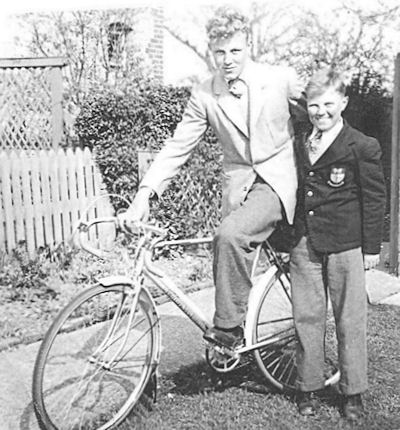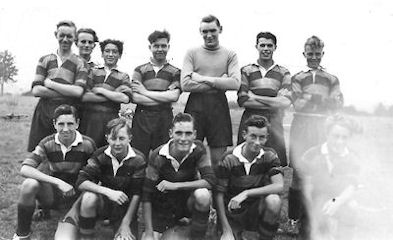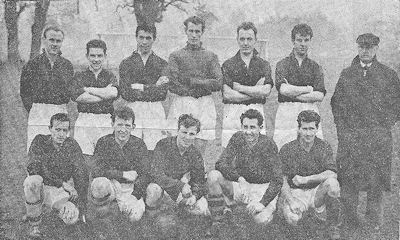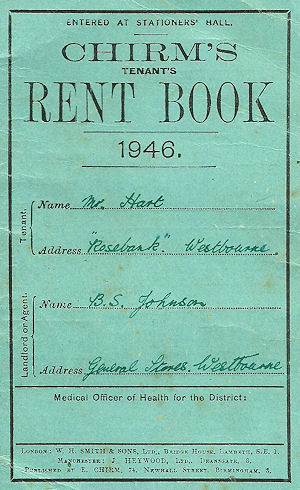|
Cycling
My grandfather, James Turnbull, made my
first bicycle when I was about 7 years. It was an ASP [all spare parts] as a
new bicycle was unaffordable. Anyway, as a chauffeur he had a mechanical bent
and probably enjoyed the opportunity. The frame too large for me to reach the
pedals so blocks of wood had been attached. With much wobbling we did my first
tour up Horndean Road, along Southleigh Road and back to Emsworth on Westbourne
Road. I cannot recall ever using it again.
 In later years my parents bought my first new
bicycle. It was the latest sports lightweight called a 'Vox Populi'
manufactured by Phillips. It cost under £20, was light blue in colour,
with drop-down handlebars, 3-speed gears and of course the safety of a bell.
Over the years it was stripped down many times and painted different colours
from half-empty paint pots in my father's shed. In later years my parents bought my first new
bicycle. It was the latest sports lightweight called a 'Vox Populi'
manufactured by Phillips. It cost under £20, was light blue in colour,
with drop-down handlebars, 3-speed gears and of course the safety of a bell.
Over the years it was stripped down many times and painted different colours
from half-empty paint pots in my father's shed.
One of my school
friends was Tony Gosling who lived at Bosham. His father had a small nursery
mainly for fruit. Picking a fresh peach was a particular delight and I usually
came home on my bicycle with the front of my shirt stuffed with cox's apples.
There were also some chickens that were troubled with rats. That was my first
experience of using a shot gun; not very successfully. Also at Old Bosham lived
my uncle's parents and I used to ride over with Aunt Jude to visit them. They
were very keen gardeners and perhaps that is why my aunt & uncle were too.
A 'gang' of lads and lasses would often go swimming at Emsworth,
Hayling Island and Pilsey Island a short swim off Thorney Island. To get to the
latter we had to cross the World War 2, RAF runway and always made sure that we
looked left and right. It cannot be recalled that we were ever restricted. The
most frequent was at Emsworth, particularly when the tide was up. About a 100
yards away was a wooden hulk that we called The Ark that was always a popular
swim. Clambering up the side and resting on the deck before swimming back. On
one occasion a swimmer had a lucky break. Somehow he entered a culvert from the
Mill Pond and was swept through under the Mill House and escaped with a few
barnacle scratches. My only injury was close to the bathing hut on the Mill
Pond side where I gashed my foot on some glass.
There was one other
place that was often used in the evening. Where the river Ems turns at Deep
Springs into the canal leading down to Watersmeet House. An 18" square beam
bridged the river and was used for diving into the river. Not too deep, as you
could come up with a muddy face. Being fresh water, it could be rather cold at
times. It was also a favorite spot for some of the soldiers from the Cemetery
Lane camp site. The bridge was also used for my weekly visits to Deep Springs
to collect dog food. It was the quickest route from Rosebank to the school, and
along the canal, even on dark winter nights. On return my reward was the weekly
comics.
The main use was travelling to the Dockyard each day in the
later years of my apprenticeship. The twelve-mile journey could usually be
completed within 40 minutes by often tucking in behind lorries and dragged
along in their slipstream. The greatest challenge was coming home to be able to
beat those dockies who were returning to Westbourne via train and bus. Most of
the time this was successful. At weekends I would often go on tours of the
countryside. One of my favourites was to across the top of Portsdown Hill with
the stunning views across to the Isle of Wight. This would drop down into
Fareham for a cup of tea. Then it was off through the New Forest heading for
Bournemouth with another tea stop at Romsey.
The worst journey was to
London and back in a day. The outward journey was no problem arriving at Putney
Bridge for lunch at a Riverside café. The return trip was a nightmare as
I was very tired and darkness fell before the journey was half over. I stopped
at Guildford for fish and chips and my fatigue made me sick afterwards. The
long haul up ? by the light of my cycle lamp was most gruelling. Somehow I
arrived in Petersfield exhausted and ready to give up. However, at what must
have been a very slow pace I arrived home at about midnight. My parents were
naturally very worried, as I had not told them about my trip. They said it
looked as if my eyes were out on organ stops.
My cycling pal was
Allan Briton, a fellow shipwright apprentice at the Dockyard. We camped a
couple of times at Shanklin on the Isle of Wight. This prepared us for a Summer
holiday by riding the 260 mile journey to Lands End and back, camping on the
way. Stops on the way Dorchester, Exeter. On the outward journey we came over
the ferry at Fowey, but on the return journey came back via the shorter route
via Lostwithiel as we were running short of money and food. On our last night
near Romsey we had run out of both, but some fellow campers looked after us. He
now lives in Australia and we keep in touch via email.
The last days for
my bicycle was in 1960 when travelling from my first married home in Kidbrooke,
SE London to the Royal Naval College at Greenwich where I was on the staff.
Soon after I bought my first car a second-hand Vauxhall Wyvern at Lewisham for
£273 and a few months later moved to Scotland leaving my bicycle
behind.
Walks
In our younger days, on a Sunday evening the
family would walk to Rowlands Castle. A packet of crisps and a lemonade
refreshed us for the return journey. Another favourite walk was to catch the
bus to Emsworth to start our walk from our mother's parents home just across
the road from the Mill Pond. We walked across the fields and shore line past
Warblington Cemetery, where my parents and my mother's parents now lay at rest.
Our destination was the Royal Oak public house close to the old wooden bridge
to Hayling Island. After the usual lemonade and snack it was back to Emsworth
via Havant. I was also a bit of a loner going off for most of the day
birdwatching. A favorite route was up Monks Hill across the 3-cornered field to
the junction with the road to Rowlands Castle. There were usually some finds in
the scrub woods adjacent to the old brickfields. Each year a chaffinch family
always came back to the same tree. It was then onto the 2 Brickkiln Ponds to
watch the moorhens, coots and ducks. In the woods were pheasants and when they
were nesting you could stand a couple of feet away without them attempting to
move. Where the pond met the Stansted road here was always a carnage of frogs
as they made towards the Aldsworth Pond. This was also a good site to see more
coots, moorhens, dabchicks and the mute swans nesting in the Springtime. In the
woods could be found common birds such as thrush and blackbirds. Occasionally
the nests of long-tailed tits could be found; a superb work of art. The pond
emptied over a waterfall to pass under the road and the stream continued its
journey through the fields to Westbourne Mill. This stream was a good source
for watercress that Mrs Ambrose sometimes asked me to collect when collecting
the cows or Sandy the horse. Other birdwatching routes were through the
Standsted grounds across to the north of Aldsworth farm and back to the ponds.
A variation was onto the Racton Monument and sometimes up to the downs. Some of
these walks could take most of the day and it was never considered that I could
come to any harm and neither did my mother. I still have The Observer's Book of
British Birds.
Holidays
Like many families of that era there
were only day holidays. The best remembered were the days on the Isle of Wight.
The Southdown bus was boarded at the Cricketers Inn and the journey to South
Parade Pier took about an hour. The paddle steamer was boarded and us boys
headed for the viewing window to see the large pistons hard at work driving us
first to Sandown to drop off some passengers and then to Shanklin pier. It
would stay moored there until mid afternoon and then we would retrace our
journey. The sun, sea and sand and amusements were always great fun. One of
these coal-powered boats was called Ryde and during the war was commissioned as
HMS Ryde. It was used as a minesweeper patrolling the North sea and Dover
Straits. It had a special significance for my father when he was then working
for the Admiralty on the Mulberry Harbour Project. On D-Day this ship was one
of the invasion fleet and was stationed off Omaha beach protecting the man-made
harbour from aircraft attacks.
When we were much younger, other visits
to Portsmouth were for a walk along the front to Clarence Pier to the fun fair.
Or a ride on the miniature train near the castle and a day by the adjacent
paddling pool. One day I did not want go home and after being dressed I ran and
sat down in the pool. Mum was not best pleased.
When Dad retired from
the Dockyard he became self-employed using his skills as a plumber and
electrician. Mum and him also had a part-time job with Captain and Mrs Waterlo
Fox Royal Navy who lived in a large house and grounds on Horndean Road. Mum
used to cook and serve the meals for them while Dad did odd jobs including the
garden, that I helped with. He stwas not necessary to pass a driving test. At
one stage he had a motorcycle and later an Austin car that he used for
work.
Sports
Like most boys, football was the number one
sport. Our best friends were those who owned a football and whose parents
allowed them to come out to play. In those days the balls were made of leather
with an inner inflatable rubber lining that could get punctured. It was
contained by a leather lace similar to those used in shoes. When the ball was
wet it was like heading a lump of lead and if the lace had worked loose it
could catch in your eye. Our favourite place was the common with our jumpers
were the goal posts. A high shot at goal was often disputed as over the 'bar'.
During the war with double summer time we could be playing until near midnight.
Later I used to play for Westbourne and my brother Len too. He also played for
Emsworth with Stan Peake, who lived in Manchester Terrace. In those days boots
had nailed-on studs and were made of leather with hard toe caps. They had to be
cleaned and dubbined after each match to keep them supple and water proof; that
was the theory.
|
|
The other regular sport was playing cricket for the village
team. Bowling was more succesful that batting and in the field I was nicknamed
'buckets' for my record of catches. During the break tea would be taken at the
Cricketers Pub. Matches were well supported with family and friends. The best
venue for an away game was always Stansted Park on its wide sweeping
lawns.
As an undergraduate at Newcastle in 1955 I was attracted to a
completely different sport; rowing. Together with John Williams, my room mate,
we had 3 years of successful rowing in coxless pairs, fours and eights, winning
a few pots on the way. The major event of the year was the London Head of River
Race. The course is in the reverse direction of the annual Oxford &
Cambridge race. Over 200 crews took part from all over the country setting off
at timed intervals. During the vacations John and I kept fit by rowing from a
club in Old Portsmouth and going out to sea off Southsea. The boats were wider
and stronger to withstand the more demanding sea conditions. As a post graduate
at Imperial College, London my rowing in eights continued and for another 16
years in my working life. My favourite position in a boat was at
stroke. |


 The family moved from 6 The Grange to
Rosebank, Commonside on 20th January 1946. The handwriting on the rent book is
that of Mr Johnson, the landlord, who charged a weekly rent of 20 shillings.
Perhaps we were fortunate in obtaining our new home as it is believed that Mrs
Johnson was a distant cousin of my father. Whatever, we pleased with our our
semi-detached house with our own front garden. It looked across the road to Mrs
Hellyer's shop on the corner of School Lane.
The family moved from 6 The Grange to
Rosebank, Commonside on 20th January 1946. The handwriting on the rent book is
that of Mr Johnson, the landlord, who charged a weekly rent of 20 shillings.
Perhaps we were fortunate in obtaining our new home as it is believed that Mrs
Johnson was a distant cousin of my father. Whatever, we pleased with our our
semi-detached house with our own front garden. It looked across the road to Mrs
Hellyer's shop on the corner of School Lane.  UTILITY was
introduced in 1941 by government minister Hugh Dalton to offer a restricted
range of garments of simple, but sound, design, low price and guaranteed
quality. As many skilled workers had signed up to fight, and raw materials were
in short supply, manufacturers had to be more efficient in their production
methods.
UTILITY was
introduced in 1941 by government minister Hugh Dalton to offer a restricted
range of garments of simple, but sound, design, low price and guaranteed
quality. As many skilled workers had signed up to fight, and raw materials were
in short supply, manufacturers had to be more efficient in their production
methods.  In later years my parents bought my first new
bicycle. It was the latest sports lightweight called a 'Vox Populi'
manufactured by Phillips. It cost under £20, was light blue in colour,
with drop-down handlebars, 3-speed gears and of course the safety of a bell.
Over the years it was stripped down many times and painted different colours
from half-empty paint pots in my father's shed.
In later years my parents bought my first new
bicycle. It was the latest sports lightweight called a 'Vox Populi'
manufactured by Phillips. It cost under £20, was light blue in colour,
with drop-down handlebars, 3-speed gears and of course the safety of a bell.
Over the years it was stripped down many times and painted different colours
from half-empty paint pots in my father's shed.